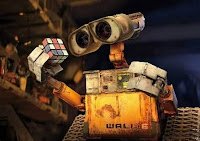WALL-E (Vic's Review)

As you may know, I also write reviews for periodicals and websites, which generally do not appear on this blog. Over the next week, I intend to post the reviews I have written in the past year (and maybe older ones, if there is a demand). These reviews were not written for the blog, but are the original (pre-edited) versions of what appeared elsewhere.
The animated science fiction film WALL-E (one of the year’s biggest hits, directed by Andrew Stanton) opens with a tremendously evocative scene of a strip mall on 28th-century earth. It’s a polluted wasteland covered with trash, but we can still see all the ads for Buy N Large, the Wal-Mart-like chain of superstores that must have taken over the planet (or at least the U.S.) in the 21st century, offering every conceivable item and service, including the space ships which were used to evacuate the earth when the toxicity levels rendered the planet uninhabitable.
The ship was only supposed to be gone for five years while Buy N Large cleaned up the planet, but the clean-up proved too difficult. 700 years later, the cruise ship is still sailing through space and the only “life” on earth is WALL-E, a small clean-up robot who creates skyscrapers with his squares of compacted garbage.
With almost no dialogue, the first half-hour of this gorgeous intelligent film shows us how WALL-E’s daily routine (which includes watching old musicals) is disturbed by the arrival of a female robot. This is followed by a delightful romance and a journey to the space ship Axiom.
On the Axiom, people have been taking an endless cruise, with every need met and every super-sized food and beverage available for purchase and consumption. As a result, people have become so large they can no longer even stand. “Buy more, eat more and be happy” say the ads on the Axiom. It’s an obvious exposé of our 21st century consumerist lifestyle, a lifestyle that will make the earth’s inhabitants fat and lazy and eventually destroy the planet.
When WALL-E arrives on the Axiom, he disturbs the routine of its passengers, waking them up from their dreamlike stupor. “I didn’t know we had a pool” says a woman, seeing her surroundings with open eyes for the first time. But my favourite line comes from the captain, who, after “waking up”, tells the autopilot (patterned after HAL, the malfunctioning computer of 2001: A Space Odyssey): “I don’t want to survive, I want to live!” To me, the message is clear: Those of us living as slaves to 21st century consumerism are in a dreamlike state of survival; we have forgotten how to live.
Besides opening the eyes of the blind, WALL-E brings good news to the poor and oppressed, hangs out with those who have been marginalized by our corporate culture (after freeing them from captivity) and sacrifices his life to save humanity before being raised from the dead. Sound familiar? Like WALL-E, Jesus’ mission was to open our eyes to what is happening in the world around us and free us from enslavement to the Domination System which has created a world headed toward self-destruction. 2000 years after Jesus, his message and mission are as vital as ever. It’s up to those of us who want to follow Jesus in the 21st century to be like WALL-E, waking people up from their consumerist nightmare, protecting the environment and, of course, watching lots of old musicals.
That this film was made by Disney, one of the world’s great consumer-promoting corporations (which has no doubt sold millions of WALL-E robots to children), is astonishing. It is either a sign of hope or of the crassest cynicism.
Not that WALL-E is perfect. I hope those of you who have read my reviews of other children’s films will have picked up on the seemingly inevitable redemptive violence in the film. In particular, I was disturbed by the way the little red-topped robot “villain” was thrown off the captain’s bridge to fall to his “death” on the floor below, just like countless Disney villains before him. This time, because it’s a robot, children even get to see the body crash and die. But WALL-E and Eve are also robots. They, and many other robots, have been wonderfully humanized while the villains have been dehumanized so that we don’t care if they are destroyed. But what exactly are children to make of the way the security/police robots are destroyed by WALL-E’s new friends?
Still, the messages in WALL-E are so overwhelmingly positive and radical (for Disney), the film so beautiful and delightful (with grand sci-fi visions and scenes) and the allusions to 2001 (e.g. Also Sprach Zarathustra and The Blue Danube) so timely, that I am willing to overlook a few flawed minutes and give WALL-E my blessing as a marvellous film for all ages to watch again and again (but don’t forget to take the opportunity to talk to your kids about it; and pastors: there’s a whole 20-minute sermon in WALL-E).
When I walked out of the theatre after watching WALL-E, I found myself staring at a strip mall identical to the one in the film’s opening scene. Shivers ran up my spine. I could already see the barren wasteland, the empty world of “buy more, more and more”; all that ugly concrete surrounded by polluting SUVs reminding me that I am living in a nightmare and it’s time to wake up.
The animated science fiction film WALL-E (one of the year’s biggest hits, directed by Andrew Stanton) opens with a tremendously evocative scene of a strip mall on 28th-century earth. It’s a polluted wasteland covered with trash, but we can still see all the ads for Buy N Large, the Wal-Mart-like chain of superstores that must have taken over the planet (or at least the U.S.) in the 21st century, offering every conceivable item and service, including the space ships which were used to evacuate the earth when the toxicity levels rendered the planet uninhabitable.
The ship was only supposed to be gone for five years while Buy N Large cleaned up the planet, but the clean-up proved too difficult. 700 years later, the cruise ship is still sailing through space and the only “life” on earth is WALL-E, a small clean-up robot who creates skyscrapers with his squares of compacted garbage.
With almost no dialogue, the first half-hour of this gorgeous intelligent film shows us how WALL-E’s daily routine (which includes watching old musicals) is disturbed by the arrival of a female robot. This is followed by a delightful romance and a journey to the space ship Axiom.
On the Axiom, people have been taking an endless cruise, with every need met and every super-sized food and beverage available for purchase and consumption. As a result, people have become so large they can no longer even stand. “Buy more, eat more and be happy” say the ads on the Axiom. It’s an obvious exposé of our 21st century consumerist lifestyle, a lifestyle that will make the earth’s inhabitants fat and lazy and eventually destroy the planet.
When WALL-E arrives on the Axiom, he disturbs the routine of its passengers, waking them up from their dreamlike stupor. “I didn’t know we had a pool” says a woman, seeing her surroundings with open eyes for the first time. But my favourite line comes from the captain, who, after “waking up”, tells the autopilot (patterned after HAL, the malfunctioning computer of 2001: A Space Odyssey): “I don’t want to survive, I want to live!” To me, the message is clear: Those of us living as slaves to 21st century consumerism are in a dreamlike state of survival; we have forgotten how to live.
Besides opening the eyes of the blind, WALL-E brings good news to the poor and oppressed, hangs out with those who have been marginalized by our corporate culture (after freeing them from captivity) and sacrifices his life to save humanity before being raised from the dead. Sound familiar? Like WALL-E, Jesus’ mission was to open our eyes to what is happening in the world around us and free us from enslavement to the Domination System which has created a world headed toward self-destruction. 2000 years after Jesus, his message and mission are as vital as ever. It’s up to those of us who want to follow Jesus in the 21st century to be like WALL-E, waking people up from their consumerist nightmare, protecting the environment and, of course, watching lots of old musicals.
That this film was made by Disney, one of the world’s great consumer-promoting corporations (which has no doubt sold millions of WALL-E robots to children), is astonishing. It is either a sign of hope or of the crassest cynicism.
Not that WALL-E is perfect. I hope those of you who have read my reviews of other children’s films will have picked up on the seemingly inevitable redemptive violence in the film. In particular, I was disturbed by the way the little red-topped robot “villain” was thrown off the captain’s bridge to fall to his “death” on the floor below, just like countless Disney villains before him. This time, because it’s a robot, children even get to see the body crash and die. But WALL-E and Eve are also robots. They, and many other robots, have been wonderfully humanized while the villains have been dehumanized so that we don’t care if they are destroyed. But what exactly are children to make of the way the security/police robots are destroyed by WALL-E’s new friends?
Still, the messages in WALL-E are so overwhelmingly positive and radical (for Disney), the film so beautiful and delightful (with grand sci-fi visions and scenes) and the allusions to 2001 (e.g. Also Sprach Zarathustra and The Blue Danube) so timely, that I am willing to overlook a few flawed minutes and give WALL-E my blessing as a marvellous film for all ages to watch again and again (but don’t forget to take the opportunity to talk to your kids about it; and pastors: there’s a whole 20-minute sermon in WALL-E).
When I walked out of the theatre after watching WALL-E, I found myself staring at a strip mall identical to the one in the film’s opening scene. Shivers ran up my spine. I could already see the barren wasteland, the empty world of “buy more, more and more”; all that ugly concrete surrounded by polluting SUVs reminding me that I am living in a nightmare and it’s time to wake up.

Who knows where to download XRumer 5.0 Palladium?
ReplyDeleteHelp, please. All recommend this program to effectively advertise on the Internet, this is the best program!